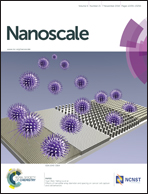Synthesis of boron and phosphorus codoped all-inorganic colloidal silicon nanocrystals from hydrogen silsesquioxane†
Abstract
We present a new route for mass-production of B and P codoped all-inorganic colloidal Si nanocrystals (NCs) from hydrogen silsesquioxane (HSQ). Codoped Si NCs are grown in glass matrices by annealing mixture solutions of HSQ and dopant acids, and then extracted from the matrices by hydrofluoric acid etching. The free-standing NCs are dispersible in methanol without any surface functionalization processes. The structural analyses suggest the formation of heavily B and P doped hydrophilic shells on the surface of Si NCs. The NCs show efficient size-tunable photoluminescence in the near infrared to visible region.


 Please wait while we load your content...
Please wait while we load your content...